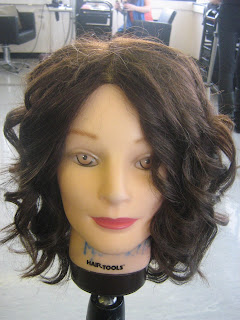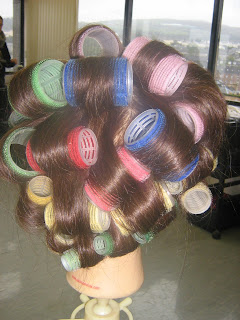A wig is essentially a piece of hair which is fitted to the head for either improving or changing one's appearance or to hide hair loss. Today, a large variety of hair pieces - such as extensions, weaves, etc - are used by people to enhance their hair for fashion purposes, and both natural and synthetic pieces are worn. Wigs and hair pieces are also used extensively in TV, film and theatre to create a variety of characters. However, throughout the ages, wigs have been used for many different purposes. Here are a few examples!
Ancient Rome
 |
| Julius Caesar |
In Roman times, hair was seen as sacred and people considered washing, cutting and dressing their hair to be something of a ritual. Wigs were worn by both men and women soared in popularity at the establishment of the Empire - during Livia's reign (58 B.C.-A.D. 29) more attention was paid to hair and how it could be styled. Empress Messalina (A.D. 17-48) was famous for her yellow wigs, which she would wear when she visited brothels. In fact, Roman prostitutes also wore yellow wigs to assert their status and profession. Women in Rome usually wore wigs to look younger and improve their appearance, but men wore them to hide their age - Julius Caesar (100-44 B.C.) wore a wig and laurel leaves to hide the fact that he was balding.
16th Century
By the 16th Century, wigs of varying shapes and sizes were an every day items for ladies, and they were starting to become more popular with men. This was largely due to the influence of Queen Elizabeth I, whose reign began in 1558. Women dyed their hair red to emulate the Queen's natural hue, and her extensive collection of wigs influenced a lasting trend. Catherine de’ Medici (1519-1589) even paid a woman to provide hair for her daughter's wig, and Mary Queen of Scots (1542-1587) amassed an even larger collection of wigs than Elizabeth I.
18th Century
 |
| Louis XIV |
The popularity of wigs maintained throughout the start of the 18th Century. People even rioted in Caen, France because of a flour shortage - aristocrats were using flour to adorn their wigs, but it was badly needed to make bread. The Death of King Louis XIV of France, however, changed the trend for grandiose, extravagant wigs to more natural-looking ones. Louis was famous for his hair - he began to bald prematurely, so he was never seen without it. He even hired over 40 wig makers to get it right, and adorned it with perfume and powder. People began to copy his style and, in contrast to today, looking old was 'in'.
By Louis' death, however, people were more interested in blending wigs with their natural hair to create a more natural look. Wigs gradually started to get smaller, and the toupee was born. This new trend had a very negative effect for wig makers - there was even a law pass to make sure men bought and wore wigs, as more and more men were favouring their natural hair. Wigs quickly began to be a symbol of the aristocracy and, by the beginning of the 19th Century, wigs were only really worn by elderly or conservative men.
20th Century
 |
| The Beatles |
Wigs made a comeback in the mid-20th Century. They were worn by Hollywood actors and actresses and people who wanted to disguise hair problems. Their convenience made them easier than ever to wear and maintain - many women took theirs to the hairdresser to be washed, coloured, styled, etc, and it even became possible to buy pre-bleached wigs. By the 1960s, the popularity of The Beatles came with new trends in hair, and more people wore wigs in order to emulate their Mod-style haircuts. Wigs were no longer stigmatised or worn only by select groups, they were once again a fashion statement and continued the trend for copying hairstyles of respected figures - which was, in the case of the late 20th and early 21st Century, celebrities.
Wigs are still used extensively today, in fact it is more common than ever to see people - particularly women - wearing some kind of hair piece to enhance their natural style. They are also used greatly in fashion, from commercial to couture, to create a variety of modern looks. As technology progresses, I imagine wigs will continue to grow in popularity and new styles and techniques will be developed.












